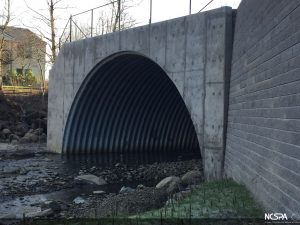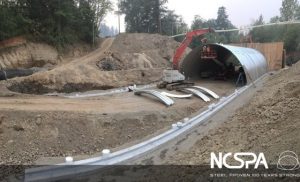By: Big R Bridge
The Stark St crossing over Beaver Creek consisted of an undersized concrete box culvert with a broken fish ladder that was prohibiting salmon and other fish species from migrating upstream through the culvert. Multnomah County and the Oregon Department of Transportation (ODOT) worked together to design a solution that would restore the natural stream habitat, allow for passage of at least 13 native fish species in Beaver Creek, and allow for expansion of Stark St above.
The design team selected at 40’9” span bottomless deep corrugated structural plate Buried Bridge, designed and fabricated by Big R Bridge, to allow ample room to restore the stream bed while allowing for increased flow. The Buried Bridge structure was constructed at a length of 150 ft to allow for future widening of Stark St to 4 lanes and to allow room for sidewalks and bike lanes – improving public safety. Salmon were observed at the new structure within weeks of completing the project – an example of the effectiveness and success seen for many environmental projects where Buried Bridges are used. The Stark St structure is part of an on-going effort to restore the health of the watershed and is helping to open up new spawning habitat upstream. Deep corrugated steel Buried Bridges are becoming the go-to solution for many similar environmental projects throughout the US.

Multnomah County produced a time lapse video of the project that includes more details of the project and their efforts to restore the watershed:
https://multco.us/roads/stark-street-culvert-time-lapse-video

